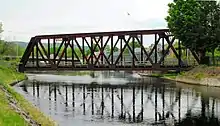
Bellows Falls Canal is a canal constructed to allow boat traffic to bypass Great Falls[1] on the Connecticut River in Bellows Falls, Vermont.[2] It was constructed by the Bellows Falls Canal Company and was one of the first canals in the United States.[3] It was used for transport, to power mills, and later for hydroelectric power. The Bellows Falls Downtown Historic District includes the canal.
The Library of Congress has a dry plate negative of the canal from 1907.[4] A historical marker on Bridge Street in Bellows Falls, Vermont commemorates the canal's history.[5]
History
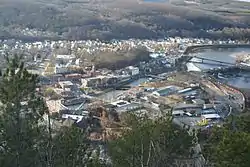
A British-owned company was chartered to make the Connecticut River navigable in 1791 and spent 10 years building nine locks and a dam to bypass 52-foot-high (16 m) Great Falls. The canal was completed in 1802.[5][6] Although it was planned and built for river transportation, by the time it opened in 1802 there was already at least one mill using the canal for water power, with more built soon after.[7]
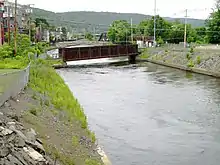
Usage declined with the arrival of railroad service in the area in 1849, and the canal ceased to carry boat traffic in 1858.[6][7] After 1858, the canal only supplied water power to the neighboring mills, of which there were six at the time.[7] After the mills were converted to electric power, the lower (southern) end of the canal with the locks was filled in, and the upper part of the canal was enlarged in 1926-28 to bring more water to a new hydroelectric generating plant built on Bridge Street, which became the southern end of the canal.[5][6][8][9] The hydroelectric plant has a fish ladder, primarily to aid the passage of American shad, with a visitors center and viewing window that is usually open in the summer.[10]
The lower end of the canal with the locks, south of Bridge Street along what is now Mill Street, is where many of the mills were built to use its power. The 1886 lithograph by Burleigh in the sidebar shows some of those mills.
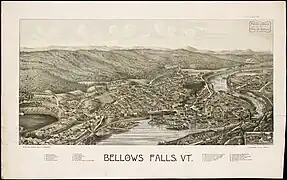
Only one of those mills is still standing, the Frank Adams Grist Mill (see photo in sidebar), the closest mill shown to the left of the large smokestack in the lower center part of the 1886 image, labeled "13". (Several other mills have the same label.)
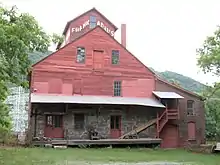
The canal ran behind where the photographer who took the picture of the grist mill was standing, on what is now Mill Street.[11] The area where those mills stood along the lower end of the canal is now a public park, the Bellows Falls Historic Riverfront Park and Trail System, located along Mill Street.[12]
References
- ↑ "Great Falls", Geographic Names Information System
- ↑ Collins, Anne L.; Lisai, Virginia; Luring, Louise (June 5, 2002). Around Bellows Falls: Rockingham, Westminster and Saxtons River. Arcadia Publishing. ISBN 9781439611555 – via Google Books.
- ↑ Thibault, Amanda (March 29, 2018). "This Place in History: Bellows Falls Canal".
- ↑ "Canal, Bellows Falls, Vt". Library of Congress. 1907.
- 1 2 3 "Bellows Falls Canal - Bellows Falls VT - Vermont Historical Markers on Waymarking.com". www.waymarking.com.
- 1 2 3 "Canals of the Connecticut River – Connecticut River Conservancy". www.ctriver.org.
- 1 2 3 Hayes, Lyman S. (1907). History of the Town of Rockingham, Vermont: Including the Villages of Bellows Falls, Saxtons River, Rockingham, Cambridgeport and Bartonsville, 1753-1907, with Family Genealogies. Retrieved November 21, 2020 – via archive.org.
- ↑ "Incidents Connected with the Bellows Falls Canal". Vermont Genealogy. Retrieved November 23, 2020.
- ↑ Lovell, F.S.; Lovell, L.C. (1958). History of the Town of Rockingham, Vermont, Including the Villages of Bellows Falls, Saxtons River, Rockingham, Cambridgeport, and Bartonsville, 1907-1957, with Family Genealogies. Bellows Falls, VT: Town of Rockingham.
- ↑ "The Bellows Falls Fish Ladder and Visitors Center". Grafton, VT: The Nature Museum. Retrieved November 23, 2020.
- ↑ "The Frank Adams Grist Mill". Bellows Falls Historical Society. Retrieved November 23, 2020.
- ↑ "The Park". Bellows Falls Historical Society. Retrieved November 23, 2020.